Standing atop the Welt of BMW’s vehicle distribution
Mathias Wellbrock is carefully driving BMW’s outbound logistics with tight, in-house control while building closer relationships with providers; all of which is becoming even more critical to the carmaker as deteriorating service levels in Europe and capacity shortages in the US and China are causing some concern, says Christopher Ludwig
Since becoming head of worldwide vehicle distribution for BMW Group at the end of 2007 (following 22 years working across the German carmaker’s inbound production chain) Mathias Wellbrock notes an important distinction about vehicle logistics: the need for constant contact with service providers to cope with market changes and individual needs. Regardless of technological advances, or perhaps in spite of them, vehicle logistics remains, for BMW, a business with a very human touch.
Such commercial communication is new for Wellbrock in part because this position–unlike his previous, more operationally-driven roles–includes more contact with external contacts in the market. But he feels that the relatively small size of the vehicle logistics sector also makes it more tactile and specific than the wider commodity transport market that inbound logistics typically fits into, such as container shipping, groupage truck services and airfreight. “Vehicle distribution is a very small part within the world of transport,” he says. “You cannot just copy trends that are related to parts logistics to that of ro-ro or car trucking. In some cases, we have completely opposite trends in rates or capacity [for inbound and outbound].”
And rarely before now has there been such a need to manoeuvre the market with a gentle yet firm grip. As BMW’s global volumes recover or even surpass pre-recession levels, providers in some regions are slow or reluctant to add transport capacity. Wellbrock identifies shortages of trucks and drivers in the US as problems, while in Europe cost pressure has negatively impacted quality, particularly as BMW finds a higher proportion of sub-contracted providers handling its volumes. In China, because of the constant growth of the market, there is a general shortage across all transport modes.

Wellbrock wants to extend a chair to logistics providers on which to sit down and discuss the current difficulties, in the hope of making the business reality less opaque for each side. “BMW would like to share opportunities with service providers. The message is not just ‘cost down,’” he says.
“We would like to learn more about our providers’ business structure so that we can better understand why something is working poorly or why it has such an uncompetitive price.” Wellbrock is optimistic that flexibility and dialogue will improve most outbound issues, including the capacity and subcontracting issues in the US and Europe. He has high praise for proactive carriers, particularly in China–perhaps surprisingly–for their openness and forward communication in a market with extremely limited assets on the ground. “Our Chinese providers are working in advance and informing us of potential issues ahead of time so that we can react,” he says. “To be honest, I was astonished at the situation, even with the big increase in the market.”
Central control
While building close ties is among BMW’s most valued asset for outbound logistics, another is keeping a tight hold over its logistics processes. Such control is notable in BMW’s outbound distribution, including a highly centralised management, a conservative approach to outsourcing, and a stable outbound delivery system.
Wellbrock’s distribution organisation is responsible for the entire budget, from the end of production to the final dealer; this includes programme planning and defining the parameters for each transport network, including quality, locations, volumes, cost and process time. Only the final contract negotiation is handled separately. Recently, the department added plant operations and vehicle distribution centres to its repertoire, putting the entire outbound chain in the hands of one team. “Being as centralised as we are now is important because we have fewer interfaces,” Wellbrock reveals.
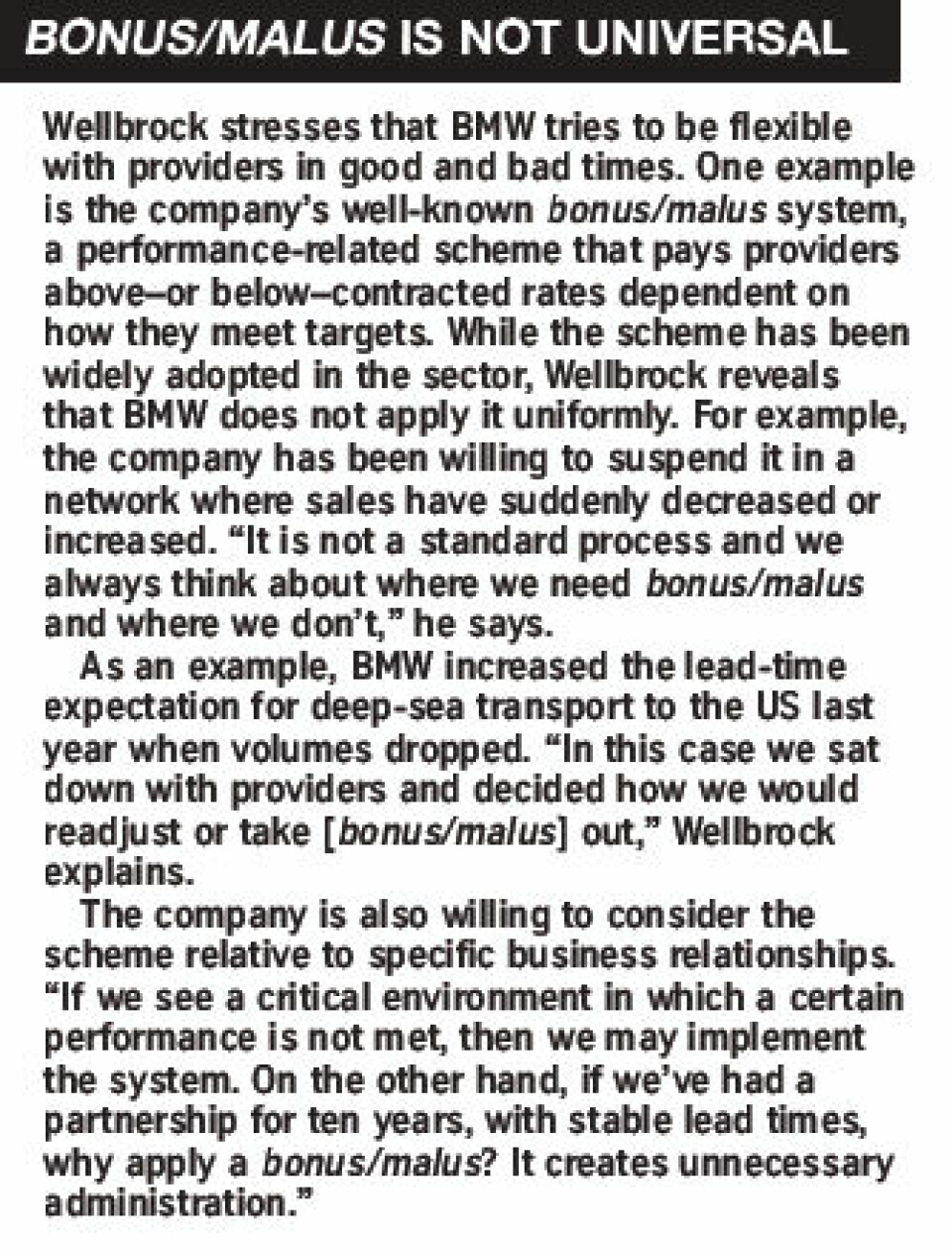
BMW replicates this central control across major markets, including–somewhat uncharacteristically compared to other OEMs–the complete outbound chain in China. This setup partly explains the high level of dialogue BMW enjoys with Chinese providers, as the carmaker plans and controls its imported vehicles all the way to Chinese dealers. “We do not have a system like some other OEMs in China where the dealers pick up their cars at the ports,” he says.
Also atypical for the Chinese market, Wellbrock’s central department takes the lead role in vehicle distribution for its local joint-venture plant in Shenyang, in northeast China. While the JV, BMW Brilliance, has autonomy, it has agreed to cede control of the outbound planning and final approval for purchasing to BMWs central team and its representatives in China. “BMW Brilliance chose to leave this control with us although legally it is not obliged to do so,” Wellbrock says. “But the company sees the benefit of BMW’s experience. It is a very good situation.”
A reserved approach to outsourcing
BMW considers control of the distribution chain a core competence, and it is thus relatively cautious in outsourcing services to third- and fourth-party-logistics providers (3PLs or 4PLs). For example, the company’s general strategy is to avoid reworking or modifying its cars after they leave the plant, and it tries to avoid setting up vehicle distribution centres that rely more on outsourced providers. However, BMW does not assume a priori that it will minimise outsourcing. On the contrary, it runs all tenders on a full plant-to-dealer basis, giving opportunities for providers to capture the entire process. “We are always open, and from time to time we use 3PLs or even 4PLs,” he says.

But in practice, BMW is more likely to outsource only small parts of the chain besides the transport to individual providers, such as for port processing or yard management. “A very small percentage could be outsourced to a lead logistics provider, but not more,” Wellbrock maintains. BMW examines factors such as volumes in a market or the number of times the car must be handled. If a region has low levels of competition with few providers, for example, BMW is more likely to consider 3PLs. One example is exports to Australia and New Zealand, where Wallenius Wilhelmsen Logistics handles the whole chain originating from factories in Europe, South Africa and the US.
Keeping a stable distribution flow
Another important feature of BMW’s vehicle distribution is stability in its order-to-delivery system. BMW’s buildto- order (BTO) system, KOPV (in English, customer orientated sales and production process) fixes orders into the production system at the dealer, and offers customers a realistic delivery date based on production capacity. The system ensures a well-planned logistics chain, but not all of BMW orders are BTO, with a high number of build-to-stock (BTS) in the US and China, for example. Nevertheless the company applies the same delivery priority to BTO and BTS vehicles. Rather than rearranging the supply chain to move vehicles in a “fast lane” or “slow lane”, BMW adheres to a stable plan. Wellbrock considers this approach fairest to customers as it treats all orders equally. It generally benefits the company as well, since BMW produces cars in more efficient batches and avoids premium logistics costs for distribution. It also tends to help logistics providers by allowing them more time to organise assets for more efficient routes and backhaul opportunities.
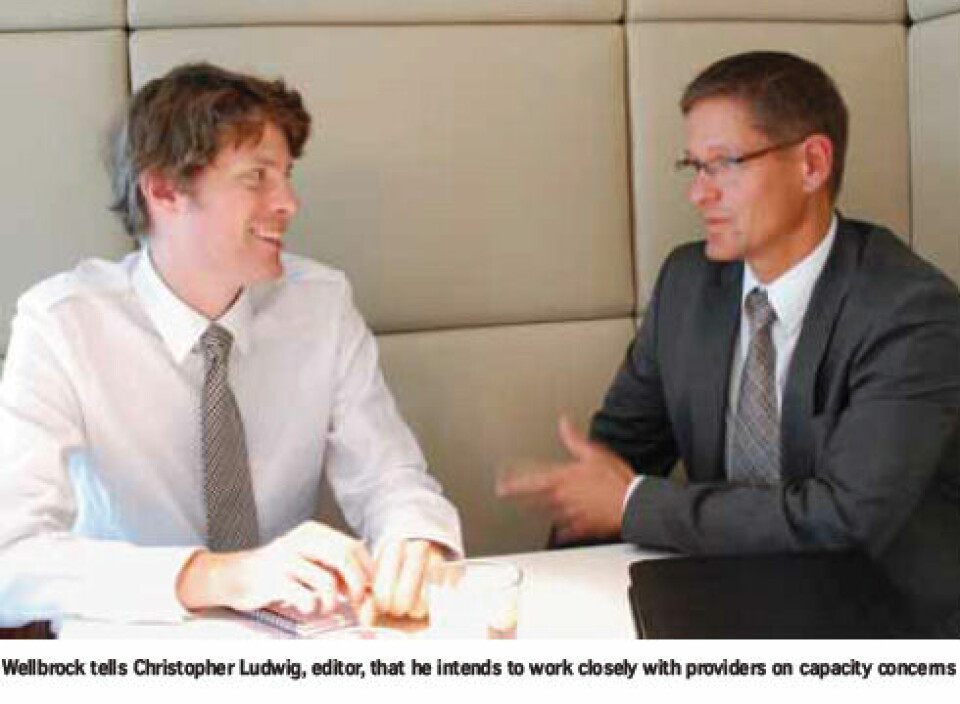
But while stability is important, Wellbrock also points out the system’s flexibility. Although a car might begin as a BTS order, it may turn into a BTO vehicle if a customer’s specifications match a vehicle in the current pipeline. This occurs most often for the US market, according to Wellbrock, where vehicles may be reassigned in transit. Such changes are another reason why assigning the same priority is important, since a vehicle may be assigned to a customer at any time. The company’s forecasting system supports BMW’s distribution stability. Its B2B platform offers information about the pipeline to all suppliers, including carriers, in a forecast as far ahead as a year at the highest level, cut out of BMW’s internal production programme; this forecast is updated every two weeks. The next level is a revolving two-week forecast. Finally, BMW provides the “F2”–daily information on what cars are ready for dispatch, updated every two hours.
Wellbrock praises the reliability of the forecasting–which is not handled specifically by his department–and says most carriers appear satisfied as well. “I have never personally heard a single complaint from a service provider that the forecast was inaccurate,” he says. “Not once, even given the dramatic shifts of recent years.”
Europe–an unexpected rise in subcontracting
Just as the global sales picture remains fractured by region, so too are the issues emerging across BMW’s primary markets in Europe, North America and China.
In Europe, where the sales outlook is mixed, BMW has noted a slightly downward trend in the quality of delivery times and the level of equipment used in the market. Wellbrock attributes this decline to the use of more subcontracted carriers by BMW’s primary providers. It is a trend the company hadn’t anticipated and one that goes against its culture of control, as it gives BMW less visibility over providers’ equipment and standards.
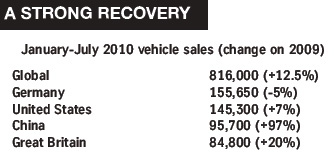
“There are situations where we are waiting for trucks to pick up the cars from our plants and in some cases we see poorer quality,” he says. “We believe the main reason is that some providers are working with subcontractors, and we don’t want to see much more of that in future.” The subcontracting appears related to the uncertainty in the European market–many providers reduced their fleet sizes following the end of the scrappage incentives in Germany and other European countries. While total German new car sales have fallen by around 30%, BMW has seen its domestic sales remain relatively stable and its exports surge. But overall, the uncertainty about market conditions, including the still depressed markets in Eastern Europe and Russia, has left many providers wary of investing or hiring. After all, it was only two years ago that many logistics companies were caught out with too many assets when sales collapsed. For many providers, the scrappage incentives were the only reasons not to ditch even more trucks, ships and rail wagons.
Wellbrock appreciates the uncertainty that providers face, and wants to tackle the issue with them. “There is no drama, but it is something we need to work on with our providers,” he says.
He also believes that providers have opportunities to improve their networks without necessarily making a large financial outlay. To this end, he hopes BMW’s forecasting and distribution system can help more. “I think there are opportunities for providers to reduce empty backloads, and I think this is the challenge we’re facing now to optimise the system,” he says.
More straightforwardly, he notes that Europe has a limited availability for covered rail wagons, made worse by the withdrawal from the market of the CRL Wagon Type from DB Schenker because of legal issues. In 2009, the use of rail for finished vehicle transport fell for BMW along with most manufacturers, as lower volumes made it more difficult to fill block trains. But as BMW’s rail use recovers, the lack of wagons is a threat. “We simply need more wagons on this side,” Wellbrock says. “Someone in the market needs to take a risk and invest.”
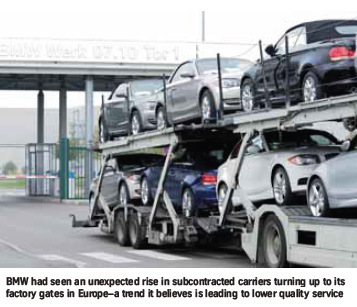
More specific to BMW’s network design, last year it applied several changes in Europe. To be more flexible, the company now allows vehicle compounds to carry inventory for crossborder deliveries. For example, a compound in Spain can now hold vehicles for dealers in France, or vice versa. BMW has also begun using the port of Santander in Spain, and likewise allows cars held there to be exported to the US. It also loosened previous restrictions on having more than one compound per country.
“We changed our compound structure so that we are closer to the market,” Wellbrock says. “This gives the service providers more of an opportunity to optimise their network too.”
North America–get the capacity in there
Compared to Europe, the North American situation shows a more acute lack of trucks and drivers. Although total volume is well off its peak, and there are concerns about a double-dip recession, the US industry faced a harsher restructuring after industry sales dropped 40% between 2007 and 2009. Furthermore, as there was not the same level of sales incentives as in Europe, more capacity and drivers were decomissioned–and it is not easy to bring either back.
“In general the processes and the equipment are more antiquated in the US compared to Europe,” he says. “But while this has improved, the real issue is the lack of drivers. They found jobs elsewhere, and service providers are struggling to recruit new ones.”
The capacity shortages have led to increased dwell times at plants, ports and yards. However, available capacity for both port handling and rail is more than adequate, Wellbrock reports, and in rare cases BMW has switched some lanes from road to rail to overcome shortages. But while he admits the situation is frustrating, he is optimistic it will not last more than six months as providers restore fleets. “We will be sitting down to discuss the problem over the coming weeks,” he says. “It is only a temporary problem.”
In the US network, BMW has continued the restructuring of import volumes from Europe that it undertook in 2008 to be closer to primary markets, switching to the port of Baltimore from Charleston in South Carolina, and on the west coast to the port of Hueneme, north of Los Angeles. Last year, in a groundbreaking cooperation, it also agreed to outsource the processing of imports in Baltimore to Daimler, as well as to co-tender with its competitor for inland distribution. Wellbrock describes the agreement as “a kind of pilot project” for collaboration. It made sense, as Daimler already had a car terminal in Baltimore with available capacity and both have similar dealer networks. Although a tedious legal process–involving anti-trust lawyers on both sides of the Atlantic–he deems the project a success, but adds that BMW will not strategically seek out such cooperation. The agreements need to benefit all sides, and the company does not believe such opportunities are plentiful enough to prioritise them. The company also does not feel that cooperation is mutually productive in the majority of cases, but can sometimes be counterproductive. It will continue to evaluate its network independently. “We remain open and from time to time we will assess opportunities with other OEMs,” he says. “But the general strategy is not to do this very often. It needs to be decided case by case.”
Wellbrock says that there are no other cooperation projects in the pipeline, but indicates that BMW remains open to opportunities. For example, it could offer its excess capacity at the port of Hueneme to another player. “It is not a cooperation thing, necessarily, but you offer your capacity on the market and if someone can share it, it could make a good business case.”
China–surprisingly collaborative providers
China has been BMW’s fastest growing market, and while the sales boom is likely to level off, the carmaker expects the market to remain strong. Given the automotive growth in China since 2009, it is no surprise there is little capacity. “The market has a real lack of capacity. Some providers are already talking about buying carrier equipment in Europe,” says Wellbrock, although he points out that the higher costs as well as European restrictions on trailer sizes make such crosscontinental deals unlikely.
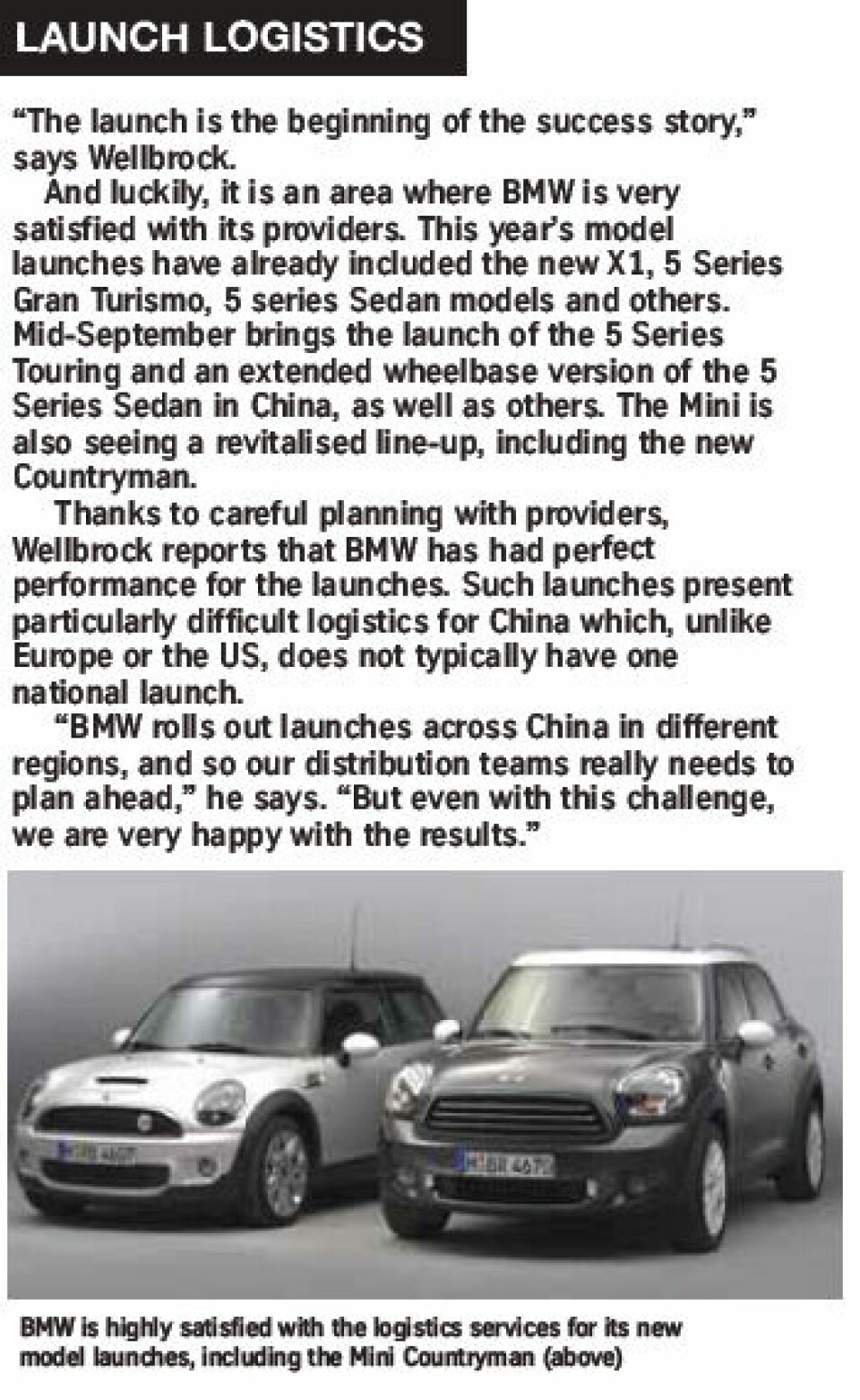
Wellbrock admits that expectations in China are “another world”–lead times are slower and unpredictable, while the standard of equipment is far below that of Europe or the US. Perhaps most critically, there is currently no available rail service in China for BMW, which means it trucks thousands of kilometres to regions such as the northwest.
“It is particularly challenging because the trucks operate a completely different system whereby the driver himself is responsible for finding a backload rather than the logistics provider,” he says. “It means that you don’t always know when the truck driver is coming back as he will search high and low for a return load, even putting a container on the back of the trailer.”
But China lacks the infrastructure and BMW alone lacks the volume to justify rail–there are no other carmakers with which to combine near its plant in Shenyang, and so future progress is likely to depend on the government. Short-seashipping rates are also uncompetitive in the Chinese market, according to Wellbrock.
Despite these issues, BMW is satisfied with the performance levels of its Chinese partners and their ability to overcome the difficulties. “We are very happy with our service providers. They have been capable, fingers crossed, to get our volume in the market,” Wellbrock says. “When I have been in China, we have had very open discussions about the market, and the providers have proved to be very reliable.” BMW anticipates no major changes to its network in China, including its three entry ports–Guangzhou, Shanghai and Tianjin–or to its growing dealer network. But Wellbrock believes that this close communication will be even more important, particularly as the market develops so quickly. “We need to keep our nose close to the market and be ready to react quickly,” he says. “The volume won’t disappear and there could be price rises, but as long as we work with our providers to optimise our network and processes, I see no risk.”
Looking ahead–IT and carbon cutting
Wellbrock is straightforward about the improvements he wants from the market: more capacity and continued control over the central processes, with as little subcontracting as possible.
Internal to BMW, he reveals the carmaker is close to finalising a tender for a new distribution IT system, in which he hopes to move to a web-enabled format that allow carriers to log on directly to share information for distribution. “One of the targets is to have 100% transparency in the pipeline so that everybody knows at each point where the vehicles are and when they are coming,” he says. Wellbrock also believes reducing carbon emissions will play a greater role moving forward, especially for premium carmakers that need to reduce their vehicles’ lifetime footprint. He says that governments should offer incentives for using low-carbon transport that may otherwise be more expensive or less flexible.
For all of these objectives, he wants to move forward hand in glove with providers. The painful days of 2009 appear only to have reaffirmed BMW’s belief in the necessity of working together with carriers even as times get better. “Even after last year, we are able to sit at the table again with our providers and look them in the eye,” he says. “We don’t want to burn our bridges.





